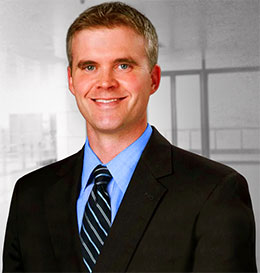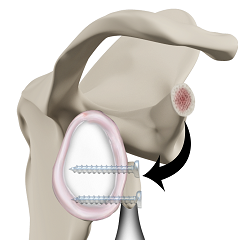
Latarjet Procedure Specialist
When a patient experiences recurrent shoulder dislocations, which is a form of anterior shoulder instability, the Latarjet procedure is a highly successful way to treat the condition. Dallas orthopedic shoulder surgeon, Dr. Brody Flanagin, offers the Latarjet approach for specific cases of dislocations and instability, as well as for trauma and congenital deformities of the shoulder joint.

Latarjet Procedure - Shoulder Dislocation Surery (Dallas, TX)
About Latarjet Repair Surgery
When a patient experiences recurrent shoulder dislocations, which is a form of anterior shoulder instability, the Latarjet procedure is a highly successful way to treat the condition. Dallas orthopedic shoulder surgeon, Dr. Brody Flanagin, offers the Latarjet approach for specific cases of dislocations and instability, as well as for trauma and congenital deformities of the shoulder joint. Each of these conditions can all be caused by bone loss or a fracture of the glenoid (part of the shoulder). The surgery involves 3 principles, or a triple blocking effect, intended to stabilize and repair the shoulder for long-term results. Depending on the patient and his or her condition, Latarjet can be performed either arthroscopically or as an open procedure. Named after French surgeon, Dr. Michel Latarjet, this is the most popular surgical method to treat anterior instability due to its excellent results and low rate of recurrence.
Surgical Technique
The orthopedic surgeon will make an incision at the front of the shoulder to gain access to the affected are. The Latarjet procedure involves transferring the coracoid (a structure on the shoulder blade that’s attached to part of the biceps muscle) with the attached muscles to the front of the glenoid (part of the shoulder) to the area that needs more support. Essentially, a piece of bone from one part of the shoulder is placed to the front of the shoulder socket. The additional bone assists in preventing more dislocations by acting as a barrier to block the shoulder from slipping out of its socket and the added muscle provides needed joint stability. By transferring the coracoid, there is actually a triple effect that occurs:
- The surface of the glenoid is restored, which eliminates the presence of any bone lesions that previously existed.
- By joining tendons together, the dynamic stability is improved, allowing for greater shoulder mobility.
- When the capsule (structure of tissue over the joint) is reattached to the bone, overall shoulder stability is improved.
During the procedure, a temporary nerve block is used to numb the shoulder and arm throughout the surgery. When the surgeon is finished, sutures or stitches will be used to close up the surgical site.
After Surgery
Since a nerve block is used during this surgery, the shoulder and arm will still feel numb a few hours following surgery, but it will subside. After the numbness, the patient should expect to experience pain and soreness which can be treated with painkillers. For about 4 weeks, the patient needs to wear a sling to protect the arm and ensure proper healing. The stitches placed after surgery are dissolvable and will disintegrate on their own. Patients should be aware that it can take several months before the shoulder fully heals, at which time he or she should be able to resume normal activities, such as driving, athletics, and weight training.
Patients often require rehab following Latarjet surgery to strengthen the shoulder and arm. The program is usually broken down into several phases to coincide with the patient’s healing progress. Our orthopedic surgeon will work with a medical team to design a plan that works best for the patient.
Latarjet Success Rates
According to various published reports, around 80-95% of patients experience an elimination of recurring dislocations after the Latarjet procedure. Compared to other methods like the Bankart repair, where there is a significant failure rate, a patient can expect more reliable results with Latarjet. In addition, athletes of contact sports like rugby or football can expect extremely favorable results to get them back to being game ready. Patients who have undergone previous shoulder reconstruction surgeries can also expect a better outcome with the Latarjet procedure.
Call today for an Appointment
Recurring shoulder dislocations can greatly affect your quality of life when you’re in pain and can’t participate in your normal activities. That’s why our practice offers Latarjet repair to stop the incidence of these bothersome dislocations. We have an experienced team ready to assist you in every step of the surgery, from beginning to end. To get started, we recommend a thorough consultation to assess your condition and to see if Latarjet surgery is right for you. Give our office a call today and we will be happy to schedule your consultation.
*Individual results are not guaranteed and may vary from person to person. Images may contain models.
Related Topics:
Surgical Treatments
- Arthroscopic Shoulder Surgery
- Open Shoulder Surgery
- Shoulder Replacement Surgery
- Rotator Cuff Repair
- AC Joint Reconstruction
- Latarjet Procedure
- Clavicle Fracture Repair
- Biceps Tendon Surgery
- Pectoralis Major Repair
- Shoulder Fracture Repair




